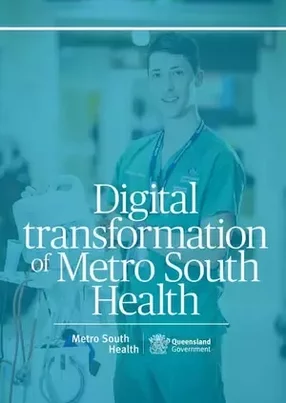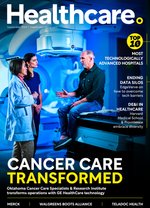Metro South Health completes digitisation of its five hospitals at South East Queensland
Metro South Health is one of Australia’s biggest and most forward-looking healthcare providers. It runs five major public hospitals and a network of community health centres across the south-eastern areas of Brisbane. Though it is just one of 16 hospital and health services in Queensland, one million people – nearly a quarter of the population of the state – depend on Metro South Health for specialist health, outpatient and hospital services.
As the leading hospital group, it has been spearheading the transformation of healthcare across the Queensland Health, working closely with its eHealth Queensland division. Queensland Health has developed a strategy for health ICT and eHealth that calls for an investment of more than $1.2bn over the next 20 years. That figures includes $730mn for clinical software such as a new patient administration system, rolling out the Cerner integrated electronic medical record (ieMR) to more hospitals and the replacement of the ageing Auslab state-wide pathology system.
The value being delivered to patients and the community became evident when data was released from the first of Metro South’s hospitals to become fully digitised. In 2017, leading tertiary facility Princess Alexandra Hospital (PAH) rolled out the full Cerner electronic medical record system, going as paperless as possible. Within a year of going digital, drug administration and monitoring errors dropped by 14%, a 33% reduction in drug dispensing and supply incidents, 17% fewer emergency readmissions within 28 days of discharge, drug costs per weighted activity unit came down by 14%, stage 3 & 4 hospital-acquired pressure injuries plummeted by 56% and healthcare associated infections reduced by 37%. In the same period early identification of deteriorating patients went up by 59%.
A clinical approach to IT
Leading the transformation was Dr Stephen Ayre, executive director of PAH at the time and now Chief Executive Officer of Metro South Health. Dr Ayre started his career at the sharp end as a GP before moving into administration: he was therefore ideally placed to take the clinicians’ point of view, and crucially that of the patients, into consideration. The work he oversaw at PAH had been started in 2014 and completed over the subsequent 18 months. The experience gained there provided a template for rolling out the programme at the other facilities, culminating in July 2018 with the completion of digitisation at the Queen Elizabeth II Jubilee Hospital (QEII).
Planning started in 2014 when the Department of Health switched to a ‘whole hospital approach’ from the module-by-module process it had previously utilised. Though the Cerner platform is a comprehensive and well-tested one, it took some work to adapt it to fit the culture and practices of Australia, says Dr Ayre: “Early in the process we decided it shouldn’t be entirely an IT project but more of a clinical change initiative. We brought a number of internal clinicians and specialists onto the team – an endocrinologist and a cardiac surgeon for example, as well as nurses and technicians. Of course, all the technical and governance aspects of the Cerner implementation were addressed, but the front facing part of it was essentially clinical.”
He has taken a lead on the involvement of the clinical users of the system throughout. “As chair of the state-wide clinical advisory group on the implementation not just at Metro South but all the other hospitals that are following on, we have been keeping the clinicians aligned and focused. We are building an integrated solution that reconciles the niche demands of specialists with the intricacies of the IT system,” he says.
Collaborative vision
It’s been hard work, one senses, to overcome the tendency for each department, often each individual, to argue from entrenched positions, so Dr Ayre has done everything possible to encourage a holistic view. “We came through a very careful engagement programme with the clinicians within the hospital so that everyone understood the process and its goals.”
Resource fairs, he explains, gave clinicians the opportunity to try out the system and see how it integrated with the devices within the hospital such as ECG machines and the anaesthetic equipment and various monitors. This helped identify pain points. A common problem when moving from standalone products to a platform such as Cerner can be a perception that functionality is reduced, for example from the anaesthetist point of view.
“In fact it allows people outside the theatre and the anaesthetic area to see what was happening with the patient. That continuity of care and management in the pre- and post-operative phase needs to be understood and worked through for the greater good of the patient,” he comments.
The ieMR – which automatically uploads observations and vital signs from patient monitoring devices, allows efficient electronic ordering of radiology and pathology tests, and provides decision support for clinicians in prescribing medicines – is the foundation technology, he explains. “Now that the patient records are integrated, all clinicians can view them – wherever they are in our organisation. There is no need for medical staff to travel to a ward to look at paper records: they can see very clearly what happened in the emergency department or in the theatre or in any other areas that a patient may be moved to during their inpatient journey. Even from one hospital to another since there are a number of hospitals throughout the state who now have ieMR.”
Soon they all will. Meanwhile work has already started on rolling the system out into the community. General practitioners can get access to certain components of the record such as pathology, radiology, medications, operative notes and discharge summaries using The Viewer. It is a function already accessible by every GP in Queensland. Software providers such as Medical Director and the pan-Australian My Health Record patient/doctor portal will increasingly be able to interface with the ieMR system to give the community better and faster access to their medical records.
See also:
- Taking a look at UCSF Health’s automated, robotic-enabled supply chain
- The Medical City: Driving positive patient outcomes through digitisation
- How Takeda’s procurement transformation has laid the foundation for medical breakthroughs
“We are very keen to provide access to information,” says Dr Ayre. “There is a whole range of patient-facing services you can update online like appointment checking and registration data. We are also interested in getting some of the community-based services onto the system.”
In the coming year, with the in-house implementation out of the way, he wants to focus on connecting care, across the five hospitals in the system and out into the community. Metro South Health’s Hospital in the Home service, which provides short-term home-based acute care in the homes of patients that formerly would have had to be hospitalised, is a good example of the type of service he’d like to see extended and enabled by the provision of ieMR.
Proving the project
Digitisation has improved efficiency, increased capacity without extra resourcing, and enhanced patient care. “I want to make sure that I can maximise these benefits while decreasing the hospital complication, readmission and infection rates and length of stay,” says Dr Ayre.
“At the same time, we're doing a lot of research around the implementation as well. There really hasn’t been much validation of this type of implementation and I am pleased to say that we have just been awarded a collaborative research grant to work with the University of Queensland, Cerner and Vancouver Health. And on the purely business benefits we are working with the University of Queensland Business School with whom we have been working closely since the inception of this programme. I am keen to take every opportunity to share the learnings from our digital transformation.”
The last four years have been a very disruptive time for Metro South Health but the outcome has been magnificent. A complex IT and clinical change project has been delivered in a very short space of time and thanks to the scrutiny it is getting from researchers it is sure to be a benchmark for future implementations in Australia and beyond.
“Speaking personally,” Dr Ayre reflects, “the biggest challenge for me as CEO has been to maintain business as usual while so much of the energy of the organisation has been focused on a single piece of work. Some change management components have also been very taxing for our staff. I'm lucky in that I have had a focused and balanced team, with health professionals working alongside IT specialists, some of them also with nursing or medical backgrounds. I am very satisfied by what we have achieved together and excited by the prospect of maximising the benefits from the implementation. My vision has always been that it’s producing really significant benefits to patient care – and that is what we are all about!”


